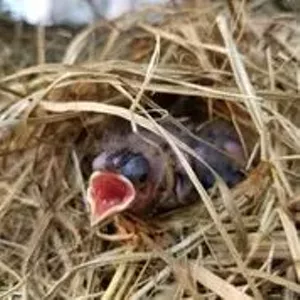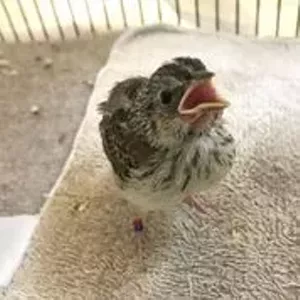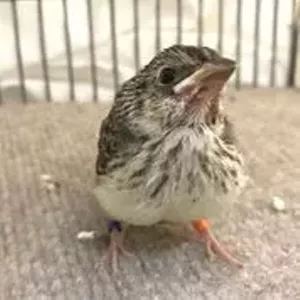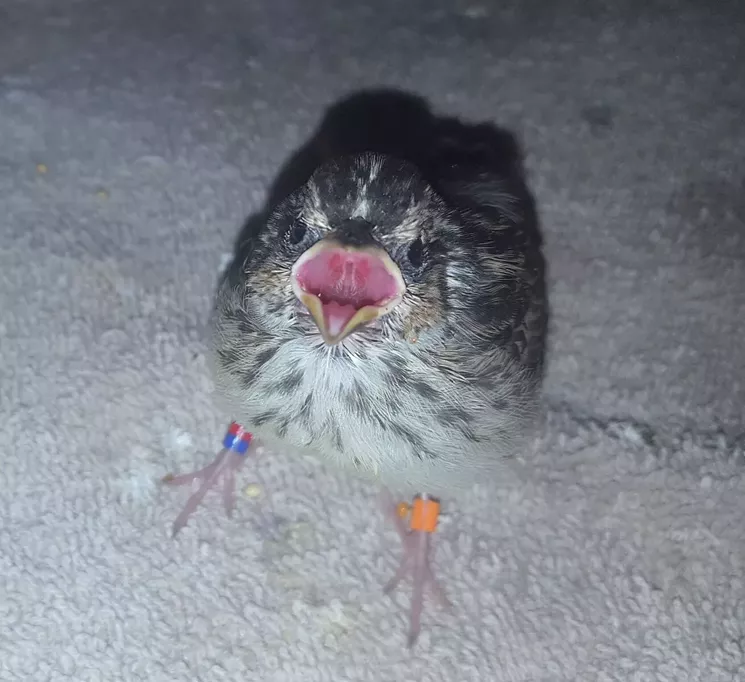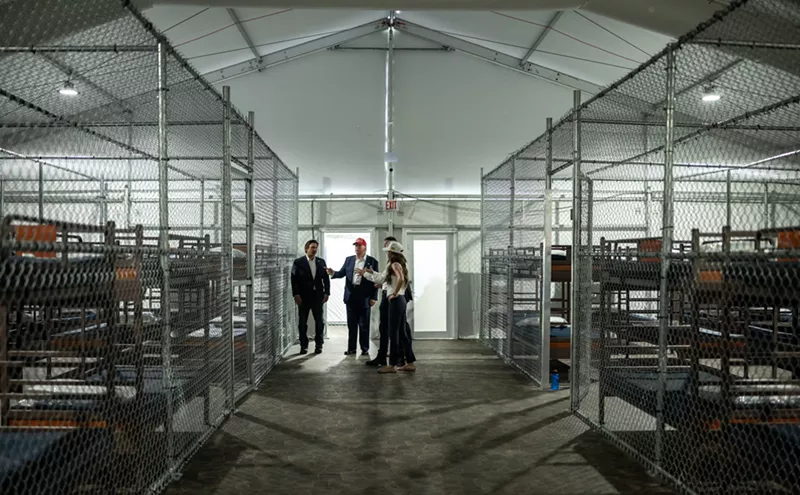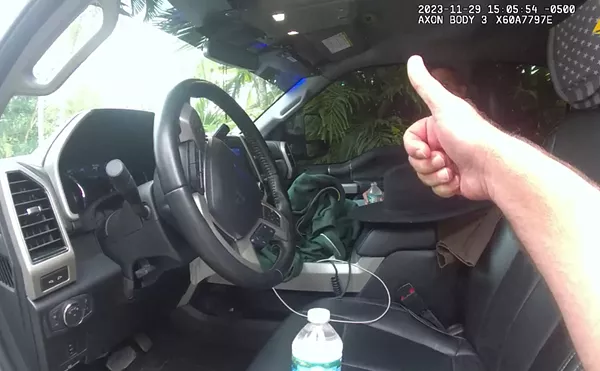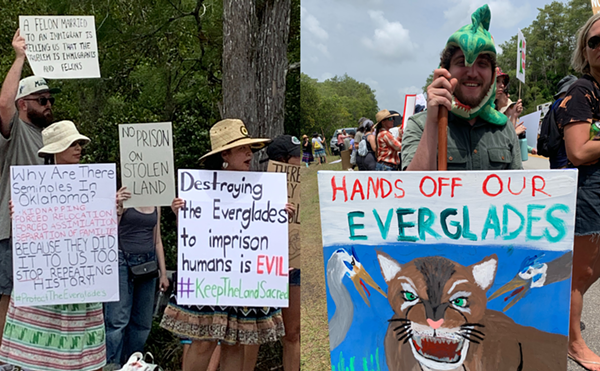As animal collection manager at White Oak Conservation Foundation in North Florida, Schumann, along with his team of two keepers and two interns, manages bird programs on the 13,000-acre White Oak Plantation miles down a dirt road in rural Yulee. Driving around the property feels like taking a worldwide safari in an afternoon; you’ll see three of the five remaining rhinoceros species—Indian, white and southern black—cavorting in open fields, feed bay leaves to a creche of reticulated giraffes, admire the magnificently curving horns of the lesser kudu and the striking stripes of the okapi, get a good look at one of few remaining P?re David’s deer, a species that is extinct in the wild.
There is no place quite like it. White Oak is not merely a showpiece, however; it is a state-of-the-art research facility working to save some of the world’s most critically endangered species.
The flock Schumann oversees comes from the earth’s far corners—the Amazon rain forest, sub-Saharan Africa, subtropical U.S., New Guinea; has hues so vibrant they could blend into a Leonid Afremov painting—double-wattled cassowaries, Mississippi sandhill cranes, southern ground hornbills; creatures so exotic they may well be the stuff dreams are made of—statuesque wattled cranes, palm cockatoos with smoky-grey mohawks, blue-billed curassows with kinky, inky-black crowns.
The few who are familiar with this diminutive songbird have a soft spot for them. They’re so darn cute,
tweet this
And now Florida grasshopper sparrows.
Tipping the scales at barely an ounce, with black and grey plumage streaked with brown and yellowish-brown, these secretive ground-dwellers from south-central Florida have neither the size, the distant homeland, nor the dramatic appearance of many of their neighbors at White Oak. Schumann’s fondness for them is plain nevertheless. He describes the “delicate” way they disassemble grasshoppers before eating them, noting with a chuckle that “they like green ones.” The few who are familiar with this diminutive songbird seem to have a soft spot for them,. That is understandable; they’re just so darn cute, hopping about with a plucky tenacity that calls to mind the sweet precociousness of children.
Researchers’ fondness for the Florida grasshopper sparrow certainly can’t hurt, for the birds need all the help they can get. Their numbers have plummeted so rapidly in the last several years that scholars estimate the likelihood of the Florida grasshopper sparrow’s extinction in coming years at approximately 20 percent. Many believe the odds are even higher. In 2013, Audobon magazine did a feature story on the sparrow titled "The Most Endangered Bird in the Continental U.S."
“It seems pretty grim,” Schumann said.
No one is giving up, though, far from it. A herculean effort is currently under way to pull the sparrow back from the brink of extinction. With its breeding program, for which it receives some federal funds, White Oak is the most recent addition to a large coalition that includes U.S. Fish and Wildlife Service, Florida Fish and Wildlife Conservation Commission, the Florida Grasshopper Sparrow Working Group, the National Audubon Society, Rare Species Conservatory Foundation, Archbold Biological Station, Florida Park Service, among others, racing the clock to save the Florida grasshopper sparrow.
First identified in 1901 in southern Osceola County, the Florida grasshopper sparrow was recognized as a distinct subspecies of the Eastern grasshopper sparrow in 1910. The two so closely resemble one another that only a trained eye can differentiate between them. The Florida grasshopper sparrow has a thicker bill, darker coloring with more grey plumage, and, most importantly, unlike its Eastern cousin, the Floridian subspecies is nonmigratory, remaining within miles of its birth throughout its lifetime. It is one of few species that is truly, and only, Floridian.
The sparrow resides exclusively on the dry prairie of the state’s interior, a harsh, unforgiving ecosystem prone to frequent fires and occasional floods, where the sun beats mercilessly from a wide-open sky. Vegetation in its habitat is primarily comprised of clumps of native grasses, dwarf oaks, and saw palmetto. It nests on the ground of this grassland, consuming bugs and a sizable minority of seeds. Though it does eat the insect, the sparrows are named for one of its buzzing, grasshopper-like calls.
The decline of the Florida grasshopper sparrow began, by most accounts, in the early-to-mid twentieth century when most of its habitat was lost to citrus, sod and pine farms and pastures. Today between 5 and 15 percent of the Florida dry prairie remains. The remaining 45,000 hectares is in mostly isolated pockets scattered throughout its original territory.
In 1978, the state listed the Florida grasshopper sparrow as endangered; in 1986, it was added to the federal endangered species list. That year, official counts estimated there were 1,000 in the wild.
In spite of the fragmentary nature
of remaining habitat, the population remained relatively stable for many years. In 2004, Florida Fish and Wildlife Conservation Commission (FWC) reported that there were 1,000 Florida grasshopper sparrows in the wild. Sometime between the mid aughts and 2012, first one, then another subpopulation went into free fall until there were steep losses across all populations. Nesting success plummeted, as did the over-winter survival rates for males. In just over a decade, the Florida grasshopper sparrow has declined by nearly 95 percent.In just over a decade, the Florida grasshopper sparrow has declined by nearly 95 percent.
tweet this
In the initial scramble, everyone knew they were disappearing, but no one knew why. Similar factors affect subgroups, but no one has been able to identify a unifying cause for its decline. Today researchers and land managers say there may be no single smoking gun.
“This are 10 problems, maybe 20,” said Schumann.
Paul Reillo, president of the Rare Species Conservatory Foundation (RSCF), the first facility to launch a Florida grasshopper sparrow captive breeding program, agrees. “[It is] most likely a combination of factors: habitat conversion, climate change, fire ants.”
This list is by no means exhaustive. Invasive hogs are another factor. Predation by other native and nonnative species is still another. And there are more extreme weather patterns as well as competition for food from nonnative species and the effect of pest-control on insect populations.
Nevertheless, the speed with which the sparrow has disappeared from the landscape has mystified those who have worked for decades to save it. Land managers have done an exceptional job restoring and improving existing habitat; researchers have generated much-needed data on behavior, diet, life cycle, etc.; U.S. Fish and Wildlife has also contributed significantly with both funding and public outreach. With more problems than solutions, it has become a sprint to preserve what remains of the wild population, rescue and breed as many as possible and simultaneously identify the cause for the sudden drop in population.
There had been talk of starting a breeding program, but the necessity was seen as relatively low until unprecedented numbers of Florida grasshopper sparrows started disappearing from the wild. In 2015, wildlife officials rescued eggs from flooded nests and transported them to RSCF; of the 23 eggs, incredibly, 21 hatched. They were the first to hatch from incubation.
“That’s kind of a major feat technologically because those eggs are so, so small,” said Reillo.
Today some of those same sparrows are in RSCF’s breeding program, a huge, and crucial, feat for any such endeavor. The sparrows had never bred before, so their first nesting attempts this year were a bit hit or miss, with females sometimes laying eggs outside the nest, then not sitting them. (Researchers remove these eggs and incubate them. On July 1, RSFC hatched the first egg to be incubated from day one—another major coup.)
As the breeding season, which runs from roughly April to July, has continued, the birds’ performance has improved. In yet another positive sign, genetic testing has found that the birds are not suffering from inbreeding depression, which often affects endangered species. These successes have researchers feeling cautiously optimistic.
Still, captive breeding is essentially a Hail Mary attempt to save a species. Sometimes it works; sometimes it doesn’t. Both White Oak and RSCF have incorporated lessons learned from other programs, such as the dusky seaside sparrow breeding program, which failed to save it from dying out in 1987. In the case of the dusky seaside sparrow, which lived in the salt marshes of Merritt Island and the St. Johns River west of Titusville, the breeding program began too late. Others, such as the California condor program, have successfully thwarted extinction.
A lot depends on how a creature responds to captive breeding. Happily, perhaps miraculously, not only can Florida grasshopper sparrows be successfully hand-reared, an intense undertaking that requires feedings every 30 minutes to hour for 18-24 hours a day for the first week and a half or so; they also breed very well in captivity.
White Oak started with three wild-caught pairs and five offspring. By mid-June, they had 18 chicks. Researchers have observed sparrows attempting five nestings in a single season, and Schumann said that by the time the breeding season ends, their sparrows could rear as many as 24 more. Wild-caught pairs always breed better than birds raised in captivity, but RSCF has found that even captive-raised sparrows will successfully breed.
White Oak’s management style differs from most breeding programs, were birds are kept in a more traditional, controlled environment. Its sparrow enclosures are built atop a grassy area measuring 30 feet long by eight feet wide and eight feet tall, creating as close to a natural habitat as possible. “I found a spot that if I was a grasshopper sparrow, I would live there,” Schumann said of how they selected the site.
Though it’s over 200 miles north of the sparrow’s habitat, the open field containing the 14 enclosures, six of which house Eastern grasshopper sparrows, which White Oak bred as it designed the program for the Floridian subspecies, does remind one of a miniature prairie. Schumann said they were encouraged when, during migration, some Eastern sparrows stopped over for a while before continuing northward.
Breeding in a more natural environment does present some challenges, though. Before they could safely breed sparrows, they had to contend with over 90 invasive fire ant nests nearby. Controlling these voracious eaters with poison is not only relatively ineffective, it could harm the sparrows—a non-option. They brought in entomologist Joshua King, an associate professor at the University of Central Florida who has developed a diesel-powered machine that heats a large quantity of water to 150°F, which is then pumped into ant mounds with a probe, killing all within minutes. First used in 2015 to control fire ants near sea turtle nests at Fort de Soto to great success, King’s provisionally-patented, eco-friendly breakthrough in ant control is a lifeline for the Florida grasshopper sparrow.
King said that though it’s long been known that hot water kills fire ants, before his invention, there was no practical way to do it in the field, a source of great consternation for researchers. “What we’ve seen with the
grasshopper sparrow, [ants] kill all the hatchlings that emerge,” King said. Now when wildlife officials locate a nest, they place fencing around it to keep out other predators, such as snakes or even cattle on private land, then he follows, driving in with the machine on a trailer to treat all ant mounds within 10 meters of the nest.“The combined effort has resulted in not losing any chicks… this is making everybody happy,” King said.
tweet this
“The combined effort has resulted in not losing any chicks… this is making everybody happy,” King said.
Fire ant predation doesn’t explain the sudden drop in all populations, however. Erin Ragheb, an assistant research scientist with FWC, studies Florida grasshopper sparrows at the Three Lakes Wildlife Management Area, which, along with Avon Park Bombing Range and Kissimmee Prairie Preserve State Park, is one of three public lands where the sparrows are found. (There are a handful on private lands as well.) Unlike the other two, Ragheb said that Three Lakes, where the largest wild population resides, had only identified one possible case of ant predation. This year, nest cams revealed that snakes and Eastern spotted skunks, all native species, were helping themselves to the tasty babies Reillo referred to as “the potato chip of the bird world.” Three Lakes is currently exploring solutions.
Improving lower-than-usual rates of nesting success is critical, but that alone will probably not save the Florida grasshopper sparrow. “There is no subpopulation that is doing well. There’s no subpopulation that is doing less bad than the others,” said Reillo. “They’re all crashing very badly.”
Most of the dry prairie was converted decades ago and land managers have developed precise techniques that today offer more and better habitat than existed for many years. Yet before its population collapsed, the sparrows weren’t utilizing all existing habitat and nest predation, though serious, doesn’t alone explain the freefall. “We’ve recorded low rates of adult animal survival but we have not pinpointed the cause,” said Ragheb.
Recently, scientists may have come a crucial step closer to solving the mystery. Birds that perished in captivity, including juvenile offspring, have provided researchers with tissue samples that can be helpful understanding what is killing the sparrows. “A suite of potential diseases are affecting these birds in the wild and in captivity and a suppressed immune system could very well be part of that puzzle,” said Reillo. “…The suppressed immune system could make those diseases far more serious.” They are working with the University of Georgia College of Veterinary Medicine Infectious Disease Laboratory and the University of Florida and to identify the cause. The research is still in the early phases, but, if successful, scientists may figure out what’s killing and
possibly how to save the Florida grasshopper sparrow.Sometimes conservation heroes come from the private sector, individuals who can make a huge difference with their philanthropy.”
tweet this
“The key to this, in terms of the little bit of the science, is if we can isolate these pathogens, then we can culture them, which means we have them growing somewhere, then we can sequence them,” said Reillo. “…Hopefully we can engineer a solution. Maybe it’s already there, some birds could be already resistant.”
This breakthrough, along with the early successes with captive breeding, have breathed fresh hope into what until very recently seemed an utterly desperate situation. But there is still much ground to cover.
Outreach programs have been helpful in increasing public awareness, which improves the chances of saving any endangered creature. But with the federal government considering drastic cuts to Endangered Species Act funding, private support may be the only way to save the Florida grasshopper sparrow. Time is running out; a few years’ delay could be the difference between extinction and recovery. “We have to do this through partnerships,” said Reillo. “…Sometimes conservation heroes come from the private sector, individuals who can make a huge difference with their philanthropy.”
Captive breeding programs are crucial to keeping the subspecies viable long enough to solve the mystery of its collapse—and may also help deliver the solution to why the tenacious little sparrow is disappearing from the wild. Even as they celebrate recent triumphs, everyone fighting for the Florida grasshopper sparrow acknowledges that it is an uphill battle.
“There’s a huge amount of challenges. We all know it. But we’ve got to try.” Schumann smiled. “I’m optimistic.”
Sign up for the White Oak e-newsletter by texting WHITEOAK to 22828.
To donate to the Florida grasshopper sparrow, visit FishWildlifeFlorida.org/florida-grasshopper-sparrow-fund.
The article first appeared in Folio Weekly in Jacksonville.



